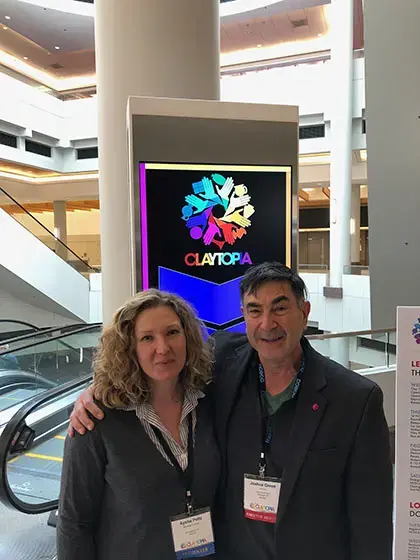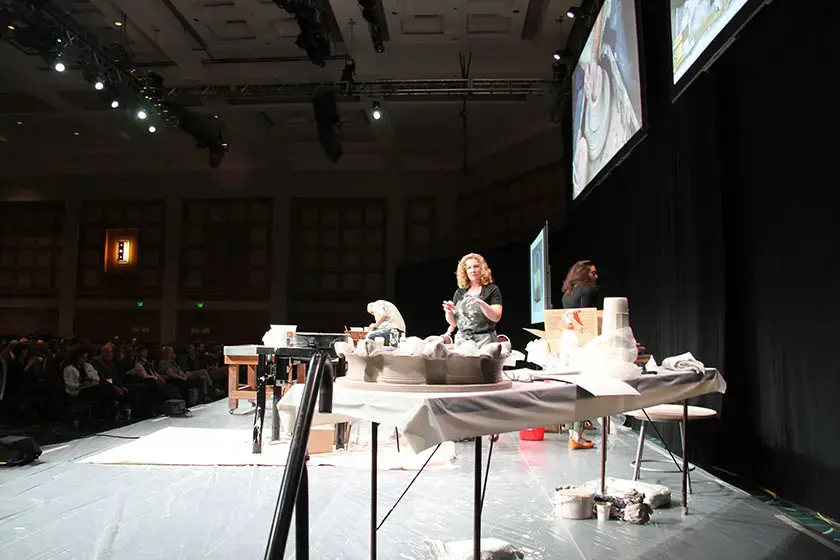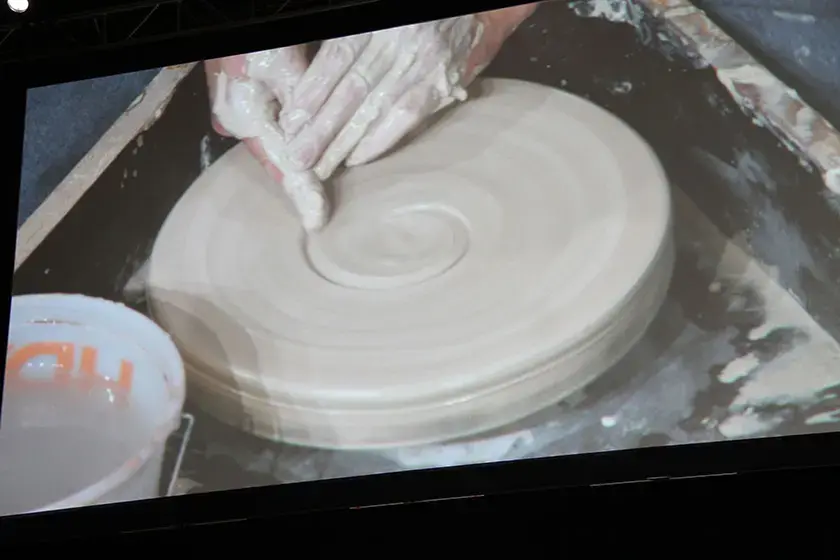Claytopia Conversations
“In higher education, ceramics is often taught with a community-oriented spirit,” said Joshua Green ’81. “Students work together in a common space and in front of one another. They’ll put their works together in a kiln load that’s then fired collaboratively. Ceramics tends to draw in students who value community.”
As the executive director of the National Council on Education for the Ceramic Arts (NCECA), Green has spent his career immersed in the collaborative world of ceramics education.
From March 27 - 30, 2019, NCECA hosted Claytopia, its 53rd annual conference, in Minneapolis, MN. Over 7,000 ceramic artists and enthusiasts attended the conference, which included three days of diverse programming at the Minneapolis Convention Center and related art shows throughout the city.
[Claytopia] was a convergence of Bennington generations.
Molly Fleiner-Etheridge '19
Faculty member Aysha Peltz was a demonstrating artist at this year’s conference. She invited Molly Fleiner-Etheridge ’19 to join her as her assistant.
Fleiner-Etheridge, who studies ceramics at Bennington, had previously attended Claytopia in 2018 when it was hosted in Pittsburgh, PA.
“As a ceramics student, getting to go to the NCECA conference is a huge deal because you're exposed to so many people and new ideas,” said Fleiner-Etheridge. “It's a huge moment for networking and getting involved in this community, and you come back with a lot of ideas and inspiration.”
“In this digital age, arts organizations like NCECA grapple with the question of relevance: do practitioners still think it’s necessary to travel to be with their people?” said Green. “To organize an event like 2019’s Claytopia, you have to put your mind and heart to work creating something that feels relevant and urgent enough that people will want to take the time to make the trip and have this experience.”
Claytopia now hosts a national K-12 art exhibition, a nonprofit-helmed ceramic art exhibition, a series of multicultural fellowships, and high-profile presenters and keynote speakers. This year, Claytopia’s keynote speaker was environmental activist and two-time vice presidential candidate Winona LaDuke.
“Over time, NCECA’s keynote speakers have featured inspirational figures who may not be working in ceramics, but who open the door to discussing culture more broadly,” said Green.
For Fleiner-Etheridge, Claytopia also provided a chance to learn more about potential paths into the art world.
“During the conference, I went to a talk that discussed the value of being an MFA student as a ceramicist, which is something I think and talk about with Aysha a lot,” said Fleiner-Etheridge. “It was interesting to go to a meeting that featured a panel of professors who teach at grad school, led by a current grad student, and to be in this crowd of potential future grad students. Not only did I get to hear what they had to say, but I also got to look around at all the other people in attendance who are in the same position as me.”
River Valadez ’20 and David DaSilva ’18 also attended this year’s Claytopia. DaSilva is currently a resident artist at the Washington, DC-based District Clay Center. He enjoyed the networking opportunity Claytopia provided and, like Fleiner-Etheridge, found the graduate school panel valuable.
“I’m looking at applying to grad school at some point, so Claytopia was a great chance to speak with people who are further along that path,” said DaSilva. “Graduate school would be a place for me to work harder building inquiries and critically engaging with my work and material. It also puts me in a position to work and, at some point, teach.”
DaSilva’s current residency has also increased his technical ceramics knowledge.
“At District Clay Center, I’ve found that I’m interested in the material and firing side of ceramics as well,” said DaSilva. “Additionally, I’m learning about the managerial perspective of how to organize and run a studio.”



While at Claytopia, Fleiner-Etheridge, DaSilva, and Valadez all met with Green.
“It was a convergence of Bennington generations: the junior still in school, the senior about to graduate, the recent grad, and the alum who has gone on to host this amazing conference that brought us back together,” said Fleiner-Etheridge.
For current Bennington students and recent graduates, Green’s best advice is to embrace the challenge Bennington provides and to carry the College’s call to openness and curiosity into their future endeavors.
“When I went to Bennington, I loved ceramics, but I primarily studied writing. It didn’t quite go where I thought it was going to go: I took courses outside of my comfort zone, and I got feedback on papers that wasn’t flattering,” said Green. “By the time I graduated, I might have felt discouraged, but in the long run, that critical feedback and time spent editing has become so important to my development as a writer. Sometimes the things that feel uncomfortable or unsuccessful at the time can eventually become the most valuable lessons.”
Fleiner-Etheridge, who will take on a number of ceramics-based jobs after graduation—including as a technical assistant at Haystack Mountain School of Crafts and as a potter and intern for the western Massachusetts Hilltown6 Pottery Tour—has similarly found that pushing beyond comfort zones yields new opportunities.
“I spent a Field Work Term at Studio Potter in Easthampton, MA, where Mary Barringer ’72 was the editor of the publication for ten years. That was a great experience, totally different from the hands-on clay work I usually do,” said Fleiner-Etheridge. “I hadn’t thought about myself as a writer and editor, but Studio Potter opened to door to me thinking about myself in that way. In the arts, it’s valuable to be able to write, express yourself, and articulate your needs and what you’re trying to do.”
Fleiner-Etheridge left that Field Work Term experience feeling connected to the ceramicist community members who had contributed to the publication over the years. This summer, she’ll return to Studio Potter as a manager for its new grants program and will also be working with Barringer on an oral interview project.
“Take advantage of what you have around you at Bennington,” advised DaSilva, who found faculty and staff members always willing to support his work. “Even when I wasn’t taking a class, I could still reach out to work with visual arts faculty members who would help me use equipment, from the CNC mill or 3D printer to the woodshop or metal shop tools. There was always the opportunity to have an experience that supports your art.”
“I’m thankful to Aysha and the entire ceramics department, who have all been generous with me in terms of time, resources, energy, advice, and connections,” said Fleiner-Etheridge. “Taking me along with her to the NCECA conference is an obvious example, but faculty and staff extend that kind of help to all of us everyday.”
By Natalie Redmond, Associate Writer